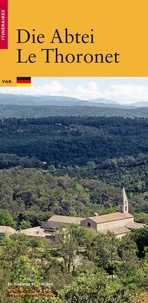There are relatively few abbeys in Provence, but the three which were built in this region are among the most famous of all : Sénanque, Silvacane and the oldest, Le Thoronet, known collec tively as the "Three Sisters of Provence'. Hidden away in a tree-lined valley which has recently been classified as a historic site, Le Thoronet abbey presents the visitor with a strikingly realistic vision of what a Cistercian monastery must have resembled in the Middle Ages.
Certain buildings linked to the daily lives of the White Monks- ; a monumental gatehouse and the ruins of a guest house, along with courtyards and walled gardens- ; still remain within the enclosure wall of the monastery. Major archaeological excavations have contributed to a greater understanding of the site. The design of the church, situated in the center of this "city', is extremely pure, while the cloisters are austere and elegant.
They are architectural masterpieces, recognised as such as early as the French Revolution, and were included in the first inventory drawn up by the Monuments historiques in 1840.
There are relatively few abbeys in Provence, but the three which were built in this region are among the most famous of all : Sénanque, Silvacane and the oldest, Le Thoronet, known collec tively as the "Three Sisters of Provence'. Hidden away in a tree-lined valley which has recently been classified as a historic site, Le Thoronet abbey presents the visitor with a strikingly realistic vision of what a Cistercian monastery must have resembled in the Middle Ages.
Certain buildings linked to the daily lives of the White Monks- ; a monumental gatehouse and the ruins of a guest house, along with courtyards and walled gardens- ; still remain within the enclosure wall of the monastery. Major archaeological excavations have contributed to a greater understanding of the site. The design of the church, situated in the center of this "city', is extremely pure, while the cloisters are austere and elegant.
They are architectural masterpieces, recognised as such as early as the French Revolution, and were included in the first inventory drawn up by the Monuments historiques in 1840.
